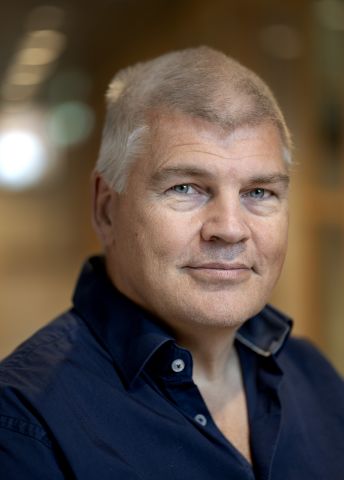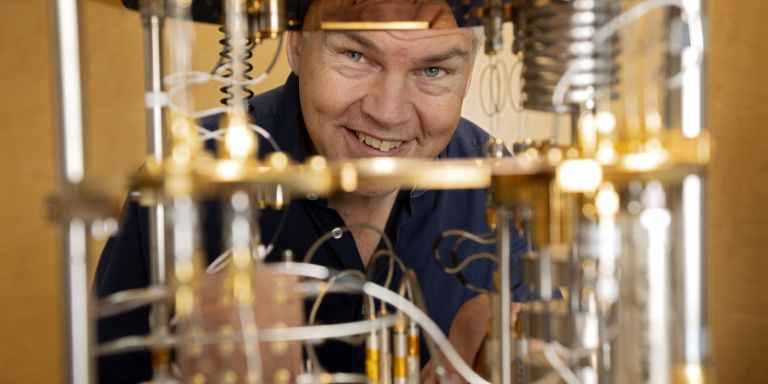
Per Delsing
Professor of Quantum Technology
Wallenberg Scholar
Institution:
Chalmers University of Technology
Research field:
Quantum physics with nanocomponents


Wallenberg Scholar
Institution:
Chalmers University of Technology
Research field:
Quantum physics with nanocomponents
For 30 years Delsing, professor of quantum technology at Chalmers University of Technology, has specialized in quantum systems and electrical circuits that behave like artificial atoms. In this microcosm, matter and energy behave differently than they do in classical physics. Delsing is very much driven by a desire to understand and derive benefit from these phenomena.
“Quantum physics is nature’s operating system. We can’t see it around us, and it doesn’t follow our intuition. It can therefore seem difficult to understand. But quantum physics can describe and make exact predictions about nature in ways that are very difficult in other disciplines,” says Delsing.
When Wallenberg Center for Quantum Technology (WACQT) was established at Chalmers University of Technology in 2018 with the primary purpose of building Sweden’s first quantum computer, Delsing was appointed director. In his role as a Wallenberg Scholar, he will be developing new, quantum technological knowledge that can open doors, both for the quantum project at Chalmers and for the global development of quantum technology.
The research team has one project in which they are literally going underground, taking superconducting* qubits with them. The project is an international collaboration in which Delsing’s team will perform experiments in a Canadian mine, two kilometers underground. The aim is to examine a fairly recently discovered problem: high energy cosmic rays can interfere with quantum computation. Hardly any cosmic radiation reaches so deep underground, rendering the mine ideal for the project.
“Cosmic radiation can create correlated errors, i.e. errors affecting multiple qubits simultaneously. This makes error correction of the qubits impossible, and quantum information is lost. We need to know more about how this cosmic disturbance occurs, so we can work out how to prevent it. We will therefore be conducting various tests and measuring the lifespan of the qubits. The first tests will be above ground; then we will repeat them underground so we can study the differences,” he explains.
If we don’t find ways to counteract cosmic radiation, we won’t be able to perform error correction in quantum computers in the future. It is therefore vital that we solve this problem.
At present there are several ideas about how to counteract cosmic radiation. The researchers intend to ascertain whether it has a positive effect if the silicon substrate on which the qubits are mounted is made thinner. They will also try to absorb the disruptive phonons – sound particles – caused by the cosmic radiation, and try out a kind of microscopic trench on the substrate designed to trap the phonons.
“If we don’t find ways to counteract cosmic radiation, we won’t be able to perform error correction in quantum computers in the future. It is therefore vital that we solve this problem. Thanks to the access we will have to the unique research environment in the mine, I think we have every chance of succeeding,” he says.
Delsing will also be addressing another challenge posed by quantum computers of the future: managing to read out quantum information from the qubits without disturbance. Quantum information signals are so low they require special amplifiers in order to read them. But current amplifiers add considerable noise, i.e. disturbance in the form of random unwanted information.
Delsing draws a comparison with a blurred, “noisy” photo in which the motif – in this case the quantum information – is harder to discern.
“Most of the amplifiers currently in use have energy losses that are noticeable in that they become warm. Those losses relate to noise. We therefore want to build new, improved ‘parametric’ amplifiers. These are microwave amplifiers, which – like qubits – consist of superconductive circuits. Since circuits of this kind have very low losses, very little noise will be added to the quantum information,” he explains.
Parametric amplifiers already exist, but given the high level of expertise at WACQT, Delsing’s research team hopes to further enhance the technology.
“The goal is to build a really good amplifier that can be used to read out quantum information with minimal noise,” he says.
The world of physics has fascinated Delsing since he was a young child. When he was ten, he saw the moon landing on TV and was immediately captivated.
“I thought it was amazing, and concluded that I had to do something similar when I got older,” he says.
He didn’t become an astronaut, but was soon fascinated by physics, and all the questions that remain unanswered in the field. During his time as a doctoral student, he became acquainted with quantum physics, and felt he had definitely found his niche. The discipline gives free rein to his curiosity, and his drive to discover and understand new things.
“Quantum physics has so many astonishing phenomena that have no counterparts in classical physics. It’s hugely enjoyable to try to understand and make use of those phenomena. It’s also fun to work with so many gifted people from across the world – like our PhD students. Some of them are cleverer than I am!”
Text Ulrika Ernström
Translation Maxwell Arding
Photo Johan Wingborg
Superconductivity is a phenomenon that occurs in a material under a given critical temperature. A superconductor can conduct electric current without energy loss or electrical resistance.